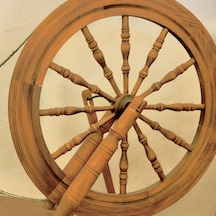

Simply put, spinning (or handspinning) is the craft of taking a clump of fibers and twisting them into a continuous spiral strand. This process makes a “singles,” which is then twisted back with another singles in a “ply” to make a much stronger yarn.
A variety of tools can be used, but the spinning wheel is the most efficient and easy tool. Besides, who can resist using something straight out of a fairy tale?

After the industrial revolution and the creation of the Spinning Jenny in industrial textiles, the craft of spinning loose fibers by hand into a strong and useable yarn was nearly lost. In the 1960s and 1970s, as part of the hippy culture, there was an upsurge in the popularity of handcrafting which resulted in bringing back as hobbies many of the ancient skills once necessary for survival.
Spinning is part of the “Slow Living Movement,” emphasizing local, handmade, sustainable, and mindfully created food and garments.
Most people these days don’t give a second thought to where their clothing came from, or all the steps involved in creating it. The convenience of big department stores and ready made clothing makes it unnecessary to even wonder; but part of living a greener, more eco friendly life means slowing down and thinking about those processes. Who made your clothes? How far did they come before you found them at the store? Were there chemicals involved? Were the people who worked on them paid enough for their time?
Learning to spin yarn brings the handspinner close to our ancestors, slows down time as a form of meditaion, and brings awareness of the painstaking processes that are really involved in creating a single article of clothing.
If you want to know more, here are some pages you may be interested in:

Comments are always welcome here at SlowYarn! Tell us what you think, share your ideas, or comment on the content. Or you can contact me directly at Kelley@SlowYarn.com.
Thanks!
–Kelley
Copyright © 2013- 2024 Kelley Adams. All rights reserved.
All text, photos, and graphics are the property of Kelley Adams, unless credit is given to an alternative source.











